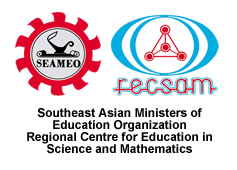Editorial Board (Issue 8 - 2013)
Suhaidah Tahir, PhD (Chief Editor)
Corrienna Hj Abdul Talib, PhD (Coordinator)
Ng Khar Thoe, PhD
S. Kanageswary Suppiah Shanmugam, PhD
Thien Lei Mee, PhD
Hazura Ab Bakar, PhD
Nur Jahan Ahmad, PhD
Julito C. Aligaen
Ong Mei Yean (Editorial Assistant)
Contents
1. Facilitating Cooperative Learning Among Matriculation Biology Students (pp. 1-9)
Miranda P. Yeoh
This paper reports on a study that examined the effectiveness of cooperative learning (CL) as compared to individualistic learning. The subject matter tested was a topic of Biology i.e. 'Expression of Biological Information'. An earlier quiz had showed that the subjects from both groups were not significantly different in terms of test performance. However after CL was structured, the mean for the experimental group was 14.25 (SD=3.23), while the mean for the control was 9.19 (SD=1.91). Independent samples t-test showed that this difference was significant t(62)=7.629, p=.0005). Students who participated in cooperative learning had performed significantly better than the control group. This agrees with most of the literature reviewed. I conclude that by its very nature, CL is effective to stimulate higher order thinking and critical thinking, and that more research should be carried out on the use of CL for science education in Malaysian schools and colleges.
2. Exemplary Practices In Search For Youth Science And Mathematics Researchers (Series 3): 'Science Project/ Problem/ Programme-Based Activities Incorporating Experiment Management' (SP3ACEMAN) (pp. 10-46)
Ng Khar Thoe, Dominador D. Mangao, Chin Chee Keong, S. Kanageswari Suppiah Shanmugam, Corrienna Abdul Talib & Hazura Ab. Bakar
Research in science learning revealed that learners and teachers need highly interactive conversational environments around media-rich artifacts to provide common grounds for fostering learning communications. In this third series of the article, on exemplary practices in SEARCH for youth researchers through blended learning, elaboration will be made on another sub-portal of SEARCH, entitled 'Science Project/problem/programme-based Activities inCorporating Experiment MANagement' (SP3ACEMAN) [http://sp3aceman.net]. The programme was founded in 2004 with off-line resources and incorporated with blended learning activities since 2009. Workshops were also conducted in 2011 and 2012 to replicate some of the activities adapted from previous research findings. Some main features of SP3ACEMAN that promote student-centred learning supported by ICT with threaded discussion topics related to science and mathematics learning are highlighted. Educational implications of Web 2.0 to promote and enhance 21st-century skills are also deliberated.
3. A Math Trail Experience: Connecting Mathematics And History (pp. 47-56)
Fong Ho Kheong
Many view mathematics as an uninteresting and an abstract subject; unable to see connections between mathematics and the real world. This presentation shows the experience of the author and some in-service teachers examining how mathematics can be made interesting and relevant by exploring the relationship between mathematics and history. A field trip was conducted with the teachers to Penang Fort Cornwallis and many interesting
Noor Hajratun Ain Binti Mohd Hanif & Nurul Hidayah Lucy Binti Abdullah
This action research attempts to improve teacher's classroom teaching of adding fractions with different denominators. Adding fractions with different denominators have always been a problem for the researcher's Year 5 students in the teaching and learning of mathematics. This research was conducted on 23 Year Five students by using techniques of 'caterpillar' and 'caterpillar pairs' in helping students to develop skills appropriate to add two or more fractions of different denominators. An observation was carried out throughout the teaching and learning using 'caterpillar' and 'caterpillar pairs' technique. Students' exercise books, observations in class and a diagnostic test are the main sources of data to gain insight into the effectiveness of teacher's teaching strategy. Findings indicate that students were able to grasp the concept of adding two or more fractions with different denominators using 'caterpillar' technique and
'caterpillar pairs' technique.
5. Mathematical Modelling In The Malaysian Secondary Curriculum (pp. 66-74)
Leong Kwan Eu
In this paper, the author discussed why mathematical modelling should be introduced in the mathematics curriculum at the secondary level in Malaysia. The importance of mathematical modelling process and the analysis on how Singapore and the USA had placed modelling in the mathematics curriculum are presented. Some modelling examples provided are meant to provide illustrations of the modelling tasks and processes that can be linked to the current Malaysian secondary curriculum. The benefits of modelling are enormous in the mathematics classroom. One not only understands how mathematics is used in the real-world but also construct a model or physical representation that is used to solve the problem. Using the modelling processes to solve real-world problems would help one in making conjectures and reasoning that is one of the important focus in the mathematics curriculum.
6. On The Teaching Of The Representation Of Complex Numbers In The Argand Diagram (PP. 75-86)
Tan Soon Hui & Toh Tin Lam
This paper reports a conceptualisation of the teaching of the representation of complex numbers in the Argand.Existing literature on different teaching approaches of complex numbers was reviewed and the "new" method proposed here incorporates the strengths of the various traditional approaches to form a feasible lesson. A lesson outline and the lesson material with explanatory notes are included.

